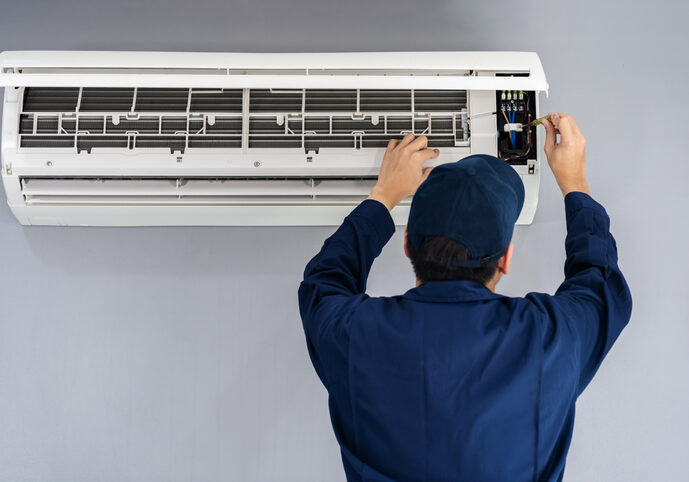Understanding the Technology Behind Ductless Mini Split Systems

Ductless mini split systems serve as an efficient solution for heating and cooling. They use simple yet effective technology where indoor units draw warm air in, pass it over evaporator coils and the outdoor compressor expels the heat outside. The real charm here is their seamless operation without any ductwork, which means individual zones can have their own temperature control. Remember how it feels when you don’t have to fight over the remote?
Ductless mini splits operate by linking individual room units to an outdoor compressor. The indoor unit contains evaporator coils cooled with refrigerant, absorbing warm air from the room and transferring it to the outdoor unit. This process allows for efficient cooling or heating of individual zones, providing optimal comfort and energy efficiency.
Ductless Mini Split Systems Explained
Picture coming back home to a room that’s just the right temperature, even if the rest of your house feels like a sauna or a freezer. That’s exactly what ductless mini split systems are designed to do—they provide personalized comfort without the need for extensive ductwork.
How They Work
Ductless mini-split systems use a simple concept to cool or heat your home: they move heat from one place to another using refrigerant. Here’s how it works: The indoor unit contains evaporator coils filled with cold refrigerant. This refrigerant absorbs warm air from the room, and then it transfers that heat to the outdoor unit, where it’s released. The result? Your room feels cooler, while the outside unit takes care of the warm air. This process is reversed in winter to bring warmth into the room.
Individual Zoning
One of the most appealing features of ductless mini-split systems is their ability to create individual zones within a building. Unlike traditional forced-air systems that rely on ductwork to distribute air throughout the entire house at once, ductless mini-splits allow for precise zoning and accurate temperature control in different areas without affecting others. This means you can adjust the temperature settings in each room according to its specific needs.
Energy Efficiency
The absence of ductwork also results in energy efficiency benefits. Traditional forced-air systems lose around 20–30% of their energy due to leaks and convection through duct walls. Ductless systems eliminate this loss by directly delivering conditioned air to each zone without passing through ducts. Additionally, inverter compressors used in many ductless systems adjust their speed based on the system’s needs, resulting in significant energy savings compared to non-inverter units.
Integration with Smart Technology
Another aspect worth mentioning is the integration potential with smart technology. Many modern ductless mini-split systems can be controlled remotely using smartphones or smart thermostats, allowing users to adjust temperatures and schedules from anywhere at any time. This not only enhances convenience but also contributes to better energy management by ensuring that energy is only used when needed.
Understanding how ductless mini-split systems operate equips you to leverage their benefits and make smarter choices for your home’s heating and cooling needs.
Distinguishing Single-Zone and Multi-Zone Systems
When it comes to ductless mini-split systems, one size doesn’t fit all. The difference between single-zone and multi-zone systems lies in their configuration and functionality.
Single Zone Systems
These systems are simple and straightforward, consisting of just one outdoor unit and one indoor unit. This setup is perfect for smaller living spaces or individual rooms that need customized temperature control. Imagine this as having your own personalized thermostat exclusive to a particular area of your home. If you have a small apartment or just want to cool down a single room, a single-zone system provides targeted heating and cooling without the need to connect multiple indoor units.
Multi-Zone Systems
On the other hand, multi-zone systems offer a more versatile approach. By connecting multiple indoor units to a single outdoor unit, they provide the flexibility to heat or cool different zones within a building. This type of system is ideal for larger homes or buildings with multiple rooms that require independent temperature adjustments. Another advantage of multi-zone systems is that they allow for personalized comfort across various areas, making them an excellent choice for homes with varied heating and cooling needs throughout different parts of the day.
Understanding the differences between single-zone and multi-zone systems is crucial when deciding which option best suits your specific requirements. Whether you’re aiming for targeted climate control in a small space or seeking flexibility and personalized comfort across multiple areas, choosing the right system makes all the difference in enhancing your indoor environment.
Installation Expenses and Procedures for Mini Splits
Installing a ductless mini-split system involves several important aspects that directly impact performance and efficiency. The installation costs are influenced by various factors, such as the number of indoor units, the placement of the outdoor unit, and the need for electrical and refrigerant lines.
Number of Indoor Units
One of the key considerations when installing a ductless mini-split system is the number of indoor units required for specific needs. Whether it’s a single-zone or multi-zone system, the number of indoor units will affect the installation cost. Single-zone systems cool or heat a single room or zone, involving the installation of one indoor unit connected to an outdoor unit. Meanwhile, multi-zone systems provide flexibility to control the temperature in multiple rooms or zones, requiring the installation of multiple indoor units connected to a single outdoor unit.
The placement of the outdoor unit is another crucial factor that affects the installation process and cost. Proper placement ensures efficient operation and minimizes potential issues. Additionally, determining the optimal location for the outdoor unit requires considering factors such as accessibility for maintenance, noise levels, and local building codes.
Factors Affecting Installation Costs
When determining installation expenses for a ductless mini-split system, it’s essential to consider the various components and procedures involved in the installation.
- Electrical Work: Depending on the electrical requirements of the system and your home’s electrical setup, there may be a need for additional electrical work to accommodate the new system. This can include upgrading electrical panels or installing dedicated circuits.
- Refrigerant Lines: Proper installation of refrigerant lines is critical for optimal system performance. The length and size of these lines impact the overall installation cost.
- Mounting: Mounting the indoor units in strategic locations requires precision and expertise to ensure efficient air distribution and aesthetic appeal. Professional installation ensures proper mounting, taking into account factors such as wall composition and structural integrity.
A typical single-zone ductless mini-split system installation may cost between $2,000 and $7,800, while a multi-zone system installation can range from $2,700 to $14,000. The additional expenses for specialized equipment or necessary electrical work can further influence the total installation cost, typically amounting to $500–$1,500. The professional installation of a ductless mini-split system is crucial for ensuring optimal performance, energy efficiency, and longevity. It involves precise sizing, mounting, and commissioning of the system to meet specific home cooling or heating needs.
Advantages of Choosing Ductless Mini Splits
Let’s begin with energy efficiency. It may not seem like a thrilling topic, but consider the substantial savings on your utility bills monthly just by choosing a ductless mini split system! These systems typically lose 20–30% less energy compared to traditional ducted systems. In other words, they’re more efficient at cooling or heating your space, translating to significant monthly energy bill savings. Not only are you saving money, but you’re also lowering your environmental impact, which is beneficial for the planet.
The individual zoning feature of ductless mini-splits is another remarkable advantage. Imagine this: You want one room to be cooler than another because it gets a lot of sunlight or because you spend a lot of time there. With individual zoning, you can have customized temperature control in different rooms or areas of your home. This means no more wasting energy on heating or cooling unoccupied spaces, resulting in even more significant cost savings.
And let’s not forget how easy these systems are to install. Traditional HVAC systems require extensive ductwork, which not only adds to the complexity of the installation process but can also necessitate substantial remodeling in your home. Ductless mini splits, on the other hand, require no ductwork at all. This simplifies the installation process and significantly reduces the need for extensive remodeling, saving you time and money. With these advantages in mind, it’s clear that ductless mini-split systems offer practical benefits that make them a compelling choice and provide numerous long-term rewards for homeowners.
Technological Innovations in Mini Splits
When it comes to cutting-edge technology, inverter compressors stand out as a game-changer in the world of ductless mini-splits. These compressors are designed to dynamically adjust their output based on the heating or cooling needs of the space, which translates to enhanced energy efficiency and consistent comfort levels. Unlike traditional HVAC systems that turn on and off to maintain the desired temperature, inverter compressors modulate their speed, thereby eliminating frequent cycles of starting and stopping. This intelligent feature not only saves energy but also extends the lifespan of the system by reducing wear and tear.
Imagine this: Instead of your mini split constantly turning on and off like a light switch, the inverter compressor operates more like a dimmer switch. By smoothly adjusting its speed, it maintains a steady temperature while consuming less power, resulting in quieter operation and more stable indoor conditions. This technology adapts to real-time changes in your space’s heating or cooling requirements, ensuring a seamless and comfortable environment without drastic fluctuations in temperature. With an inverter compressor, there’s no need to worry about sudden bursts of heat or cold drafts disrupting your peaceful setting. It operates quietly and efficiently, seamlessly catering to your comfort needs.
Moreover, advancements in Wi-Fi connectivity have transformed how we interact with our ductless mini-split systems, offering unparalleled convenience and control that aligns with our modern lifestyle.
Comparing Ductless Systems and Traditional Models
When it comes to ductless mini-split systems and traditional HVAC models, each has its own set of advantages and limitations. Let’s explore the comparative analysis.
First, let’s examine the space requirements for installation. Ductless mini splits, as the name suggests, don’t need extensive ductwork, making them a great option for buildings where space is at a premium. On the other hand, traditional models rely heavily on ductwork to distribute conditioned air throughout the building. This essential difference can significantly impact the ease and cost of installation.
Additionally, ductless mini splits offer remarkable flexibility for heating and cooling individual areas, allowing for zoning and temperature control that reduces energy consumption. In contrast, traditional models may lead to energy losses and decreased efficiency due to duct leaks and inefficiencies. This means that a ductless system not only offers better control over the temperature in different parts of the building but also ensures a more energy-efficient operation.
Additionally, the absence of ductwork in ductless systems eliminates the possibility of air escaping through leaks or cracks in the ducts, which is a common issue in traditional models. This is an important point to consider when evaluating the long-term energy efficiency and operational costs associated with both types of systems.
As we compare these two types of systems, it becomes evident that ductless mini-splits offer distinct advantages in terms of space requirements, flexibility, and energy efficiency. Their ability to provide zoned heating and cooling without relying on ductwork sets them apart from traditional models in achieving optimal comfort with minimal environmental impact.
Are you ready to experience the benefits of ductless mini-split systems? Reach out to us today at Diamond Comfort or call us at (413) 527-4737 for expert guidance on upgrading your HVAC system.
Have Any Questions?
Get in contact with us today! We are always happy to help, and you can count on our expertise.

